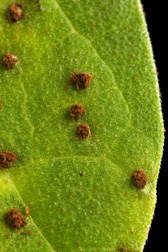This page has been archived and is being provided for reference purposes only. The page is no longer being updated, and therefore, links on the page may be invalid.
|
Read the magazine story to find out more. |
|
|
Scientists Help Rust-Proof America's Soybeans
By Jan SuszkiwJune 2, 2006
Fungicides are a key frontline defense against Phakopsora pachyrhizi, the latest fungal threat to America’s soy crop. Many of the fungicides approved for use against this exotic fungal pathogen owe their availability to the efforts of Agricultural Research Service (ARS) scientists in Urbana, Ill., and Fort Detrick, Md.
First detected in Louisiana in November 2004, the fungal disease called soybean rust has since been found in 11 other states. Two years before its arrival, though, ARS researchers Reid Frederick, Glen Hartman and Monte Miles were already busy coordinating field trials of tebuconazole, tetraconazole, myclobutanil and trifloxystrobin plus propiconazole in rust-infested regions of Zimbabwe and South America.
There, they examined fungicide timing, application methods and rates, efficacy and residual activity. That and other data expedited approval of state requests for emergency-use exemptions for the fungicides on soybeans from the U.S. Environmental Protection Agency, under section 18 of the Federal Insecticide, Fungicide and Rodenticide Act.
Key findings included showing that all of the fungicides studied by the ARS scientists reduced soybean rust severity, although their effectiveness and residual activity varied. Some, for example, worked better than others when rust was severe, according to the researchers.
Frederick, a molecular biologist, is in the ARS Foreign Disease-Weed Science Research Unit at Fort Detrick. Hartman and Miles, both plant pathologists, are with the ARS Soybean/Maize Germplasm, Pathology and Genetics Research Laboratory in Urbana. Since 2003, they’ve examined more than 30 active ingredients representing both single and dual-active fungicides, according to Miles.
The researchers caution that fungicides are a short-term solution to the problem. Over the long term, the battle against soybean rust will require a combination of strategies, with disease-resistant soybean cultivars as the cornerstone. Other ARS teams, meanwhile, are examining other aspects of fungicide use, including the influence of soybean planting dates, row spacing and maturity groups.
Read more about the research in the June 2006 issue of Agricultural Research magazine.
ARS is the U.S. Department of Agriculture’s chief scientific research agency.


